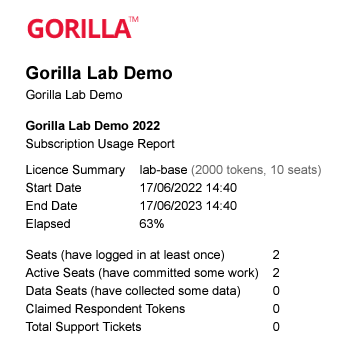Browse the list of topics in the menu for more information on how to administer a lab or team subscription in Gorilla.
If you are the manager of a department subscription, please see our support information for department subscription managers.
Creating a Gorilla account is always completely free. We charge per-participant, which means you don’t need to pay until you’re confident that Gorilla works for you. It also makes it cheap to run small studies and student projects.
Our subscriptions essentially work by creating a big shared pool of tokens. Subscription users will still have their own, individual accounts that exist independently of the subscription, they'll just be able to access tokens (the paid part) through the subscription. Subscription Administrators control who has access to the subscription and (on department subscriptions) how many tokens each user can take from it.
As Subscription Administrator, your role is to control who in your lab or team has access to your subscription.
This includes:
Watch the video guide below to learn how to use our subscription tools!
Length (mins): 5:28
Interested? Click here to access the email template mentioned in the video.
You can access the subscription management tools by logging in to Gorilla, clicking on the top right menu and selecting My Subscription, as shown below:
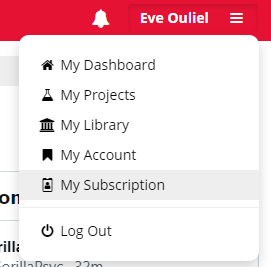
Alternatively, you can access your subscription from the right hand side of your My Account page

For any queries relating to your subscription, we have a dedicated support channel available for subscription administrators - just email subscriptions@gorilla.sc.
We've taken the liberty of drafting an email that will help your lab or team understand what Gorilla is, and how it can be useful to them, as quickly as possible.
New Lab Subscription to Gorilla Online Experiment Builder
The lab has purchased a subscription to the Gorilla Online Experiment Builder (https://www.gorilla.sc). If you create tasks or experiments for use on computers or tablets, this tool may be useful for you!
Gorilla is a tool for building and hosting behavioural experiments or tasks for use on computers, tablets or phones without needing to code. It collects reaction time data by default, so it can be used for behavioural research. Once your task is created, you can deploy it online for participants to take part remotely, or you can test people in the lab.
Because Gorilla is online it is easy to:
If you want to get started:
Curious to know more? Find out at the links below:
You can invite users by going to the Members section and clicking Invite to subscription. To invite a user, just enter their email address, check the Roles boxes if they should be a subscription manager or technician, and hit Invite to subscription.
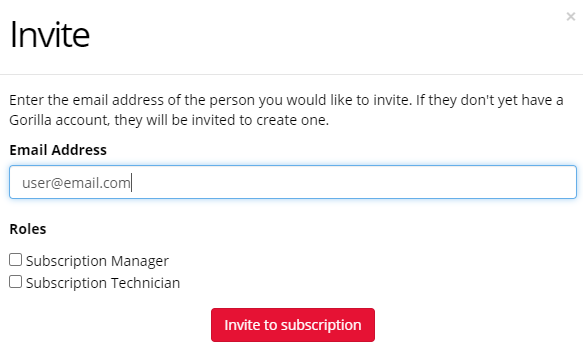
You can download a spreadsheet of all your current members from the Members tab of "My Subscription." This spreadsheet can be used to modify the member list and then re-upload to update your subscription's members in bulk.
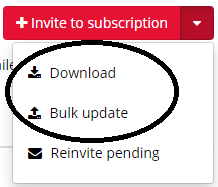
Once you click 'Bulk Update', you can then click 'Download an example' to get an example CSV file that shows you how this should be formatted.
Column headings must be formatted exactly as they are in the template CSV file. Specifically, the column headings Email and Tags must be in title case.
By default, any users in the spreadsheet not already on your subscription will be added; all existing members will remain members of the subscription, even if they are not included in the updated spreadsheet. However, if you wish, you can tick 'Remove any members not in this spreadsheet' to update your membership list such that it only contains the members in the updated spreadsheet, and any others are removed.
If any subscription members are still listed as 'Pending', you can resend their invitation to the subscription from the Members tab. You can do this
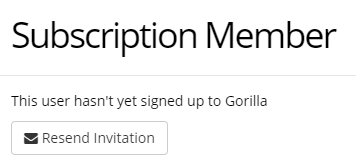
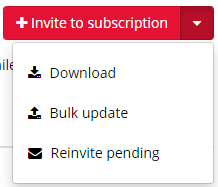
To assign tokens directly to a user, go the to Members tab in My Subscription and click the member's name:
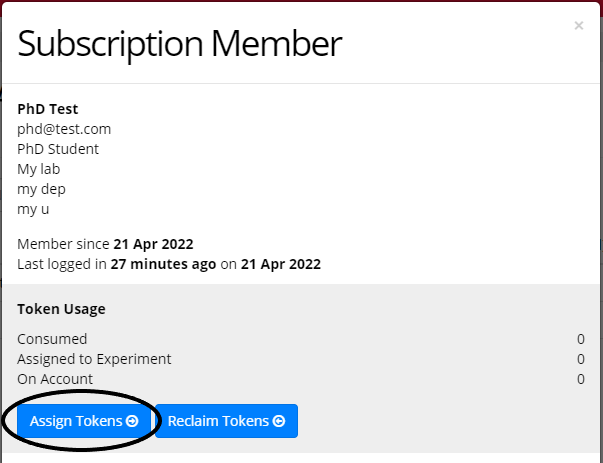
Clicking 'Assign Tokens' will open another window where you can see how many tokens the user currently has and how many tokens are remaining on your subscription. Enter the number of tokens you would like to assign to this user. Optionally, you can also 1) enter a reference and/or 2) select a specific experiment on this user's account to assign the tokens directly to the experiment.

Click 'Assign Tokens' to assign the stated number of tokens to this user/experiment. If you make a mistake, you can use the 'Reclaim Tokens' button shown in the screenshot above to reclaim some or all of the user's tokens.
To run an experiment on Gorilla, users will need to request tokens from your subscription. On a lab or team subscription, all token requests are approved automatically. However, you’ll be able to see all completed token requests via the Requests tab of your subscription page. This is helpful if you’re dividing tokens/costs between different grants.
The token request page that users see is shown in the image below. See the 'How do I request tokens?' section of our Subscriptions FAQ for a user guide to requesting tokens from a subscription.
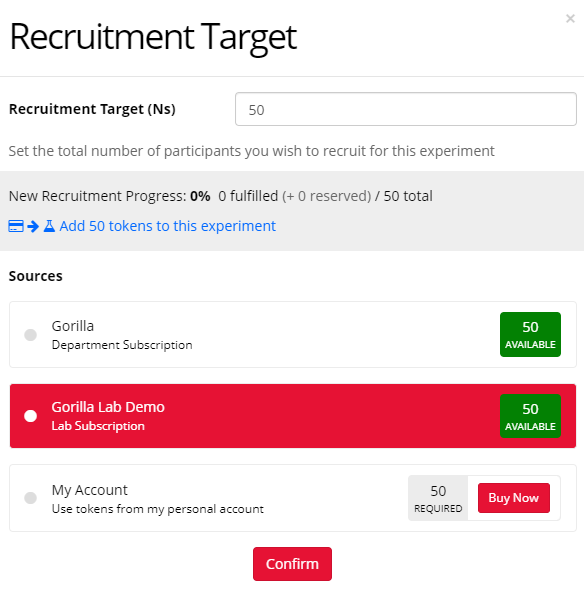
If a user is on more than one subscription, they'll be able to choose which subscription they request tokens from.
You can see a log of all approved requests on the Requests tab of your subscription by clicking the 'Show Completed Requests' checkbox.
If you click the grey Complete button by a request, you will be able to see details of the request. You can also click on a user's name for a summary of their total token usage.
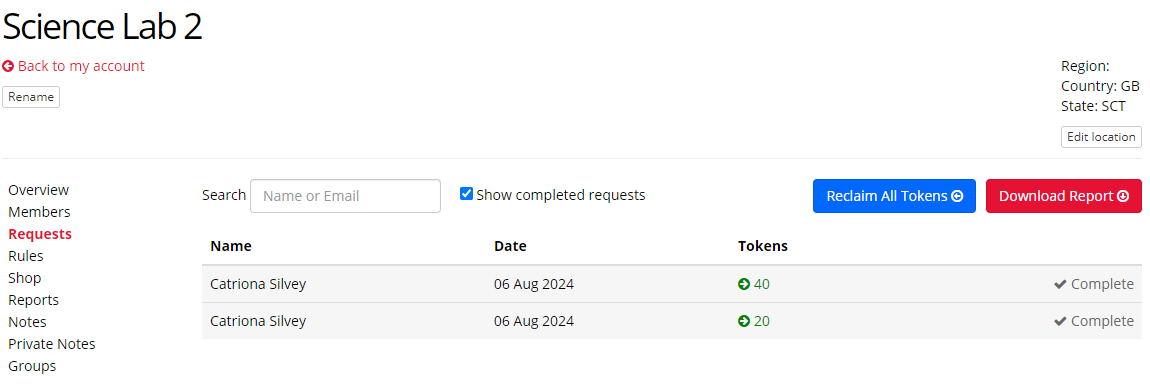
Tokens taken from your subscription by users have 3 possible states:
Consumed tokens have been used to collect data and so cannot be reclaimed.
Assigned tokens are assigned to an experiment but have not yet been used up to collect data. In order for these tokens to be reclaimed to your subscription, the user would need to first unassign the tokens from their experiment. They can do this by reducing their experiment's recruitment target. Only the project owner is able to unassign tokens from an experiment - this is a safeguard in place to protect tokens and prevent disruption to ongoing experiments.
On Account tokens are assigned to a user's account but not to a particular experiment. These tokens can be reclaimed to the subscription by a subscription manager.
There are two ways to reclaim On Account tokens: from one individual member, or from every subscription member at once.
To reclaim On Account tokens from one member, go to the Members tab of your subscription management tools and click on the name of the member you want to reclaim tokens from. You'll then see a blue Reclaim Tokens button, shown in the image below.

If you click this, you'll be shown a pop-up message telling you how many On Account and how many Assigned tokens that user has available to reclaim (see image below). If you want to reclaim already Assigned tokens, tick the box below. The member of your subscription will then get a notification to accept or reject your request. If no answer is given after seven days, tokens will automatically be reclaimed. After the tick box, you can then enter the total number of tokens that you would like to reclaim.
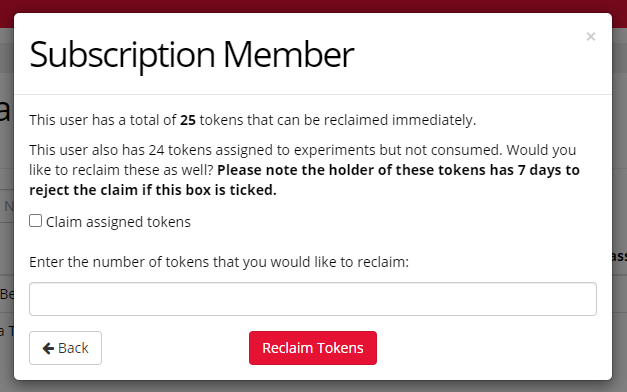
If you'd like to reclaim all On Account tokens to your subscription, you'll need to go to the Requests tab of your subscription. In the top right corner, you'll see a blue Reclaim All Tokens button. Clicking this will tell you how many tokens are available to be reclaimed, and clicking Confirm will reclaim all of those tokens to your subscription. Assigned tokens, however, can only be requested through the procedure explained above.


On the Members section, you can see a list of all the users currently on your subscription:

You can order members in the list by the total number of tokens a user currently has (by clicking the column heading 'Tokens'), or by the number of tokens a user currently has on their account which are not assigned to a particular experiment (by clicking '(Unassigned)' next to the column heading 'Tokens').
Clicking on a member's name opens a popup window where you can see their usage, set their roles, and remove them from the subscription:
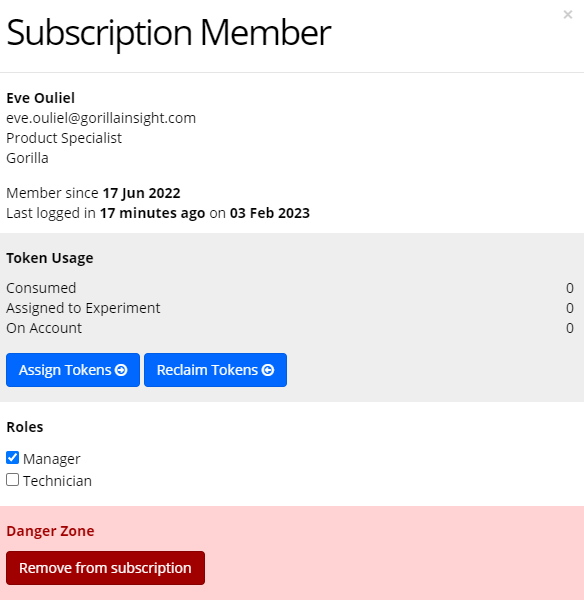
There are two special roles that you can give to members of your subscription:
1. Manager
The Manager role allows the member to view the subscription management pages and make changes to the subscription (if you're reading this, you probably already have this role). If you are on a Lab or Team account, then the user who created the subscription is the Manager and everyone else is a regular member.
2. Technician
The Technician role allows the member to access and view any project belonging to a member of the subscription, without needing to be added as a collaborator. This is useful if you wish to help your subscription members with their tasks or experiments. Members can simply send the URL of their task to the Technician, and the Technician will be able to access it. The Technician role grants read access only; if the Technician needs to make changes to the member's project, the member will need to add the Technician to the project as a collaborator.
You can download a spreadsheet of all your current members from the Members tab of "My Subscription." This spreadsheet can be used to modify the member list and then re-upload to update your subscription's members in bulk.
By default, any users in the spreadsheet not already on your subscription will be added; all existing members will remain members of the subscription, even if they are not included in the updated spreadsheet. However, if you wish, you can tick 'Remove any members not in this spreadsheet' to update your membership list such that it only contains the members in the updated spreadsheet, and any others are removed.

Give the Technician role to any member of the subscription who will be supporting other members with their projects. Technicians automatically have access to view any project belonging to a member of the subscription, without needing to be added as a collaborator.
Members who need assistance should send the Technician a link to either the specific component (task/questionnaire/experiment etc.) that they are having issues with, or the project as a whole. This link will always begin with https://app.gorilla.sc/admin/ and then some variation of project, experiment or task followed by a number. Members can find it by navigating to the task/questionnaire/experiment and then copy and pasting the URL from the browser address bar.
The Technician role grants read access only; if the Technician needs to make changes to the member's project, the member will need to add the Technician to the project as a collaborator.
To remove someone from your subscription, go to the Members section, click on their name, and choose Remove from subscription. Their membership will be deactivated, and they will no longer be able to request tokens from the subscription. They will keep any tokens from the subscription that are already on their account. If you want to reclaim tokens from a subscription member, make sure to do it before removing them from the subscription.

Their name will appear on the list of memberships with grey shading to indicate that they have been removed. When your subscription renews, their membership record will be removed altogether.
Please note that when you remove a user from your subscription, the user will still be able to access all previous projects and data on their account.
To remove users in bulk, use the 'Bulk update' option. You can find this under 'Invite to subscription' on the Members tab:

Create a CSV spreadsheet that contains the email and tags of only those users you still want to be members of the subscription. Once you have uploaded the CSV file, tick the 'Remove any members not in this spreadsheet' box and click Confirm:
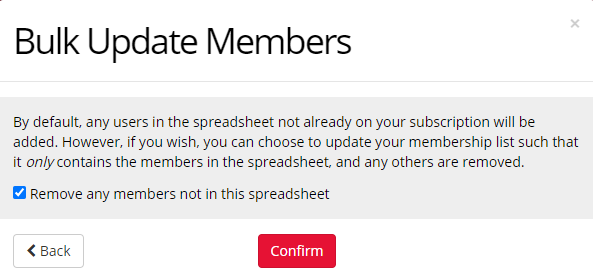
Your membership list will be updated to remove any users not included in the updated spreadsheet.
You can invite anyone in your lab, team, or research group to join your lab or team subscription. This can include researchers from multiple departments or even multiple universities.
Some universities want to prevent students from launching studies without having sign-off from ethics or their supervisor. We've included a suggestion below on how to manage workflow with a Gorilla lab or team subscription.
Supervisor as Project Owner
If you find that, over the course of the year, you require more tokens or seats, you can purchase them from the Shop:
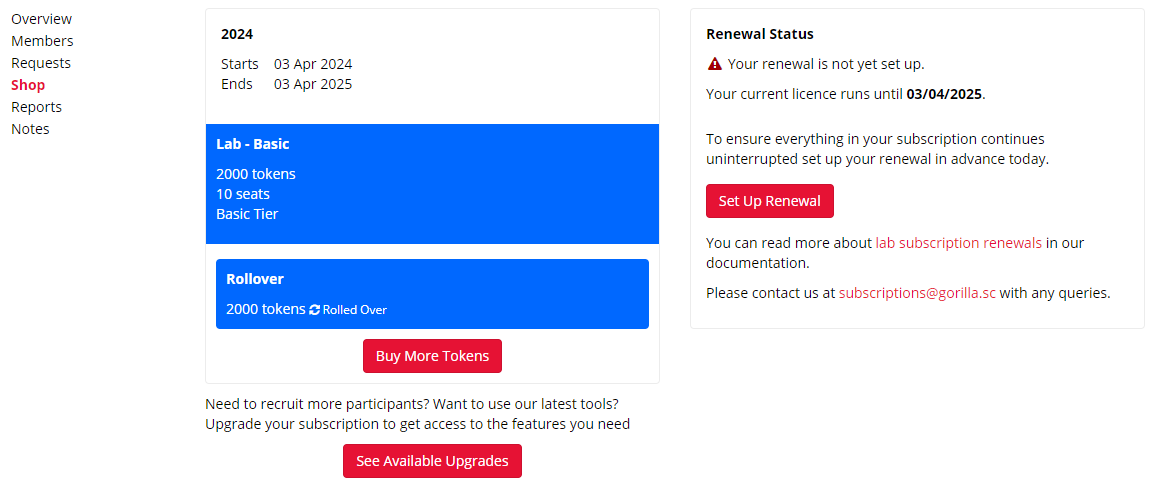
Choose Buy more tokens to choose an addon package. When you are ready to purchase, click Buy Now to pay by credit card or send a payment link to your finance team, and activate your new packages immediately. You can also upgrade your subscription by clicking See Available Upgrades.
You can also choose to pay by invoice. If you'd like to enquire about this, email us at subscriptions@gorilla.sc.
You can also email us at subscriptions@gorilla.sc if you have any questions or would rather add more tokens or seats manually.
Please note: If you want access to premium addon tools, all subscription types need to upgrade from Basic to Standard.
(There is a different process for renewing Department subscriptions - see our guide for administrators of Department subscriptions.)
If you are on a Researcher, Lab or Team subscription, and you are ready to renew your subscription, go to the Shop section and choose Set Up Renewal:
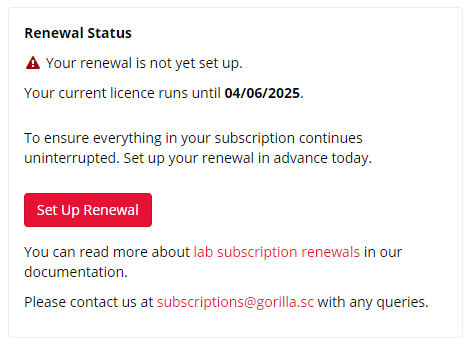
Clicking 'Set Up Renewal' will open a window where you can choose from Individual or Lab subscriptions. You can then select which subscription tier you want:
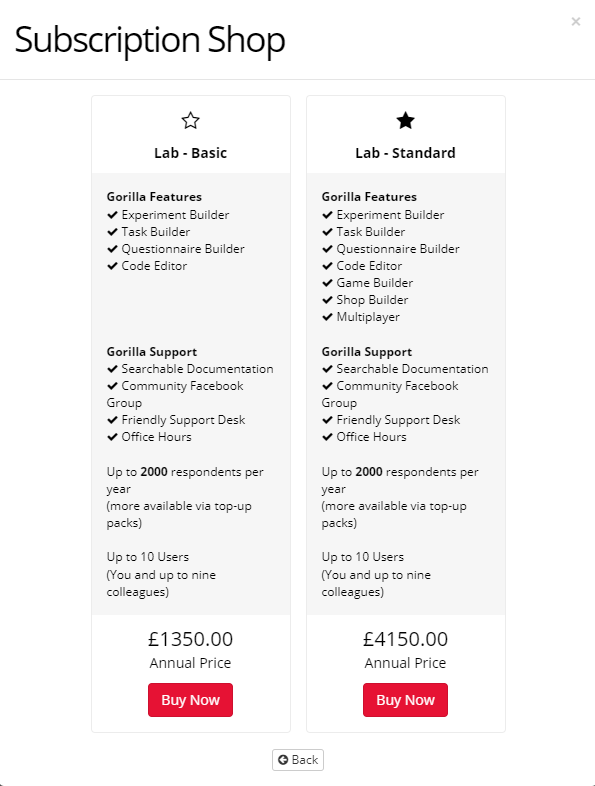
Choose the subscription you want, and click Buy Now to pay by credit card or send a payment link to your finance team. Your subscription will then automatically renew as soon as the current one expires. Once your renewal has been set up, the Renewal Status section of the Shop tab will show the details of your renewal.
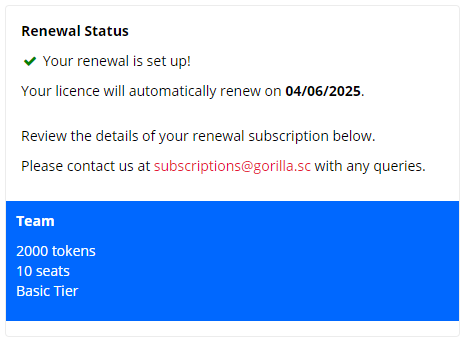
If you are on a Lab or Department Subscription, you can also choose to pay by invoice. Contact us at subscriptions@gorilla.sc, and our subscriptions team will get in touch with you to organise the paperwork.
If you have any questions or would rather renew your subscription manually, email us at subscriptions@gorilla.sc.
If you do not renew your subscription, then the subscription will expire on the date specified in the Overview tab of My Subscription. When the subscription expires, tokens that are assigned to subscription members' accounts and experiments will be automatically reclaimed. The only exceptions to this are tokens that are reserved by Live participants in experiments to prevent any disruption to live data collection.
Your base package contains an allowance of tokens that you can use throughout the year. When you renew your subscription, this allowance will return to its original limit.
For Researcher, Lab and Team subscriptions, if you need to purchase any top-up tokens during the year, and you have any left at the end of the year, you can roll them over once to the following year's subscription. This will happen automatically at renewal time.
Any rolled over tokens will be used first on the following year's subscription, before the allowance is consumed.
If you want to discuss your renewal, no matter what subscription you are on, please contact subscriptions@gorilla.sc and someone from the team will get back to you as soon as possible.
The Overview tab of your subscription will give you summary statistics for your subscription, including the duration of your subscription period, how many tokens you've used in total, and how many seats you've used.
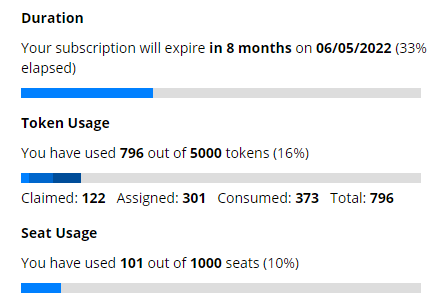
Claimed tokens are assigned to a user's account but not to a particular experiment, Assigned tokens are assigned to an experiment but have not yet been used up to collect data, and Consumed tokens have been used to collect data.
For more detailed reporting, you should go to the Reports tab of your subscription management tools. This section allows you to generate usage reports for your subscription. You can choose either a spreadsheet, which contains detailed usage data for each member, or a PDF summary containing useful totals. You may need to click the Regenerate button (found in the Download Spreadsheet or Download Report modal pop-ups) to make sure your data is up to date.
A section of the PDF summary is shown in the image below:
